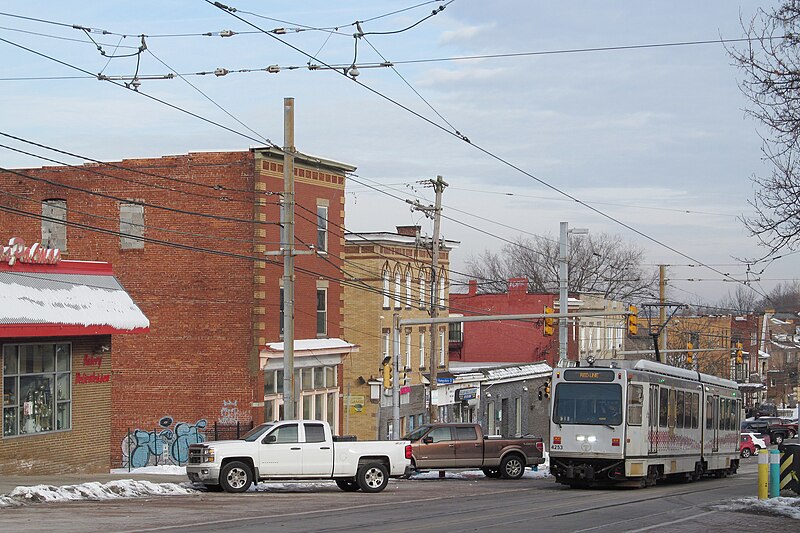
An outbound Red Line car on Broadway in Beechview passes Hampshire Avenue.


A wintry view across the Diamond or Market Square, with the Pittsburgh National Bank Building (One PNC Plaza), the U. S. Steel Tower, the Tower at PNC Plaza, and Tower Two-Sixty looming behind the square.

A view eastward on Fourth Avenue, one of the most architecturally interesting streetscapes in the world.

John Massey Rhind was Andrew Carnegie’s favorite sculptor; he gave us the Noble Quartet in front of the Carnegie Institute and the statue of Robert Burns outside Phipps Conservatory. Here he gives us some allegorical figures to adorn the entrances to the People’s Savings Bank’s splendid tower at Fourth Avenue and Wood Street. Not altogether coincidentally, the building itself was designed by Alden & Harlow, Carnegie’s favorite architects, whose firm (with their earlier partner Longfellow) was also responsible for the Carnegie Institute. Above, the Wood Street side; below, the Fourth Avenue side.


One of three fine Gothic churches in a row, this one is actually in Dormont—but not by much. The Mount Lebanon border runs down Scott Road to the right of the building, then jogs behind the building to take in the St. Clair Cemetery.
Addendum: The church was built in 1923 or after; the architect was Charles W. Bier. Source: The American Contractor, October 13, 1923: “Church: Approx. $150,000. 2 sty. & bas. 100×100. W. Liberty av., Mt. Lebanon. Archt. C. Bier, Pittsburgh Life bldg., Pittsburgh, Pa. Owner Mt. Lebanon M. E. Congr., G. W. Beams, 1225 Peermont, Dormont, Pa. Stone. Gen. contr. let to H. Busse Co., Main & Wabash av., Pittsburgh, Pa. Plmg. to Reynold Gusse, 130 Wabash av., Pittsburgh. Rfg. to Crafton Rfg. & Furnace Co., 7 Crafton av., Crafton, Pa.”

Every once in a while old Pa Pitt likes to introduce you to a back alley of Pittsburgh history known to few even of his most informed readers. Here is one of them. Few Pittsburghers are aware that Trinity Church (now Trinity Cathedral) produced a boy soprano whose talent made him a brief national sensation. We hear few boy sopranos these days, but in 1915 Master William Pickels made a few records for Victor, the most prestigious recording company, that show off his technical ability. A short notice in Pacific Coast Musical Review:
The first adequate records of a boy soprano are contributed by Master William Pickels, of Trinity Church, Pittsburgh, and two well known and popular airs are used for his Victor debut—Arditi’s “Love in Springtime” and “The Musetta Waltz” from Boheme. This young soprano is a most unusual singer. His voice lends itself admirably to reproduction, and the purity and freshness of his voice and its remarkable flexibility mark him as one of the best boy sopranos ever heard in America.
This record has been given the usual audio restoration for our sister site The Lateral Cut, which brings out a more natural bass and reduces the surface noise.

Patterned after York Minster, this English Gothic church sits on the peak of the ridge, so that its outsized towers are visible for miles.

Harry Darlington built this house in 1908 for his son, Harry Darlington Junior. The son’s house was two doors down from the father’s (separated by the widow Holmes’ house), but the two houses could hardly be more different in style. Where the father’s is tall, narrow, and massive, this is (comparatively) low and spreading. The architect was George S. Orth, who also designed the William Penn Snyder house a block away on Ridge Avenue.